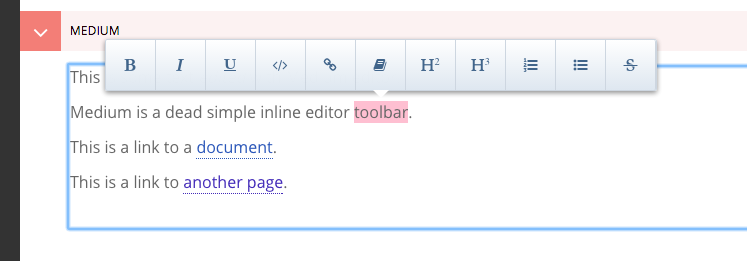Wagtailmedium is a Medium Editor integration for the Wagtail CMS.
Note: A more detailed documentation is available in .codestory format, along with a sample project to fiddle with.
- Compatible with Wagtail internal links, plus the ability to add url fragments.
- Configurable from the Django settings.
- Ability to create custom buttons (ex: text marker).
Install from pip:
pip install django-wagtailmedium
Add wagtailmedium to your apps:
INSTALLED_APPS = [ ... 'wagtailmedium', ]
3. Add a wagtailmedium widget to ``WAGTAILADMIN_RICH_TEXT_EDITORS`` (implemented by wagtail, undocumented yet)
WAGTAILADMIN_RICH_TEXT_EDITORS = {
'default': {
'WIDGET': 'wagtail.wagtailadmin.rich_text.HalloRichTextArea'
},
'medium': {
'WIDGET': 'wagtailmedium.rich_text.MediumRichTextArea',
'OPTIONS': {
'custom_buttons': {
'code': {
'contentDefault': '<b>Code</b>',
'contentFA': '<i class="fa fa-code"></i>',
'tag': 'code',
'className': 'code', # optional
},
'test': {
'contentDefault': '<b>Test</b>',
'contentFA': '<i class="fa fa-code"></i>',
'tag': 'span',
'className': 'test', # optional
},
},
'medium': { # https://github.com/yabwe/medium-editor#options-example
# 'buttonLabels': 'fontawesome',
'toolbar': {
'buttons': [ # https://github.com/yabwe/medium-editor#all-buttons
'bold', 'italic', 'underline',
'code',
'test',
'link',
'linkdoc',
'h2', 'h3', 'orderedlist', 'unorderedlist', 'strikethrough'
]
},
},
},
},
}
- Register whitelister element rules
This wagtail hook defines which HTML elements are allowed in rich text areas.
wagtail_hooks.py:
from wagtail.wagtailcore import hooks
from wagtail.wagtailcore.whitelist import attribute_rule, allow_without_attributes
# http://docs.wagtail.io/en/v1.7/reference/hooks.html#construct-whitelister-element-rules
@hooks.register('construct_whitelister_element_rules') # #7bFcf#
def whitelister_element_rules():
return {
'u': allow_without_attributes,
'span': attribute_rule({'class': True}),
'code': allow_without_attributes,
'blockquote': allow_without_attributes,
}
- Use wagtailmedium in a RichTextField of your model
models.py:
from wagtail.wagtailcore.models import Page, StreamField, RichTextField
class HomePage(Page):
# a default, Hallo editor
hallo = RichTextField(blank=True)
# a medium editor
medium = RichTextField(editor='medium', blank=True)
